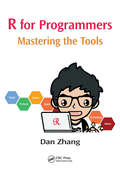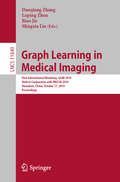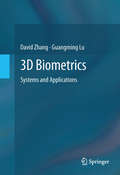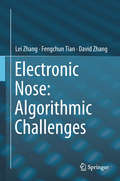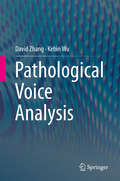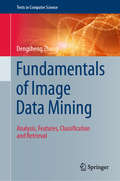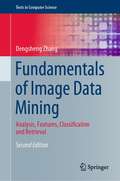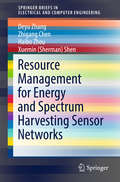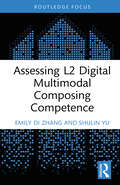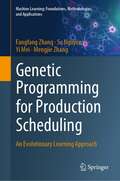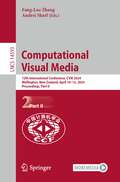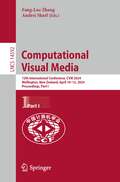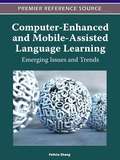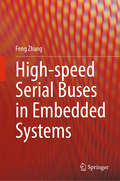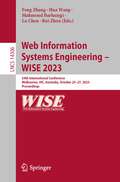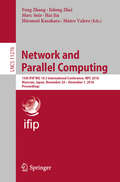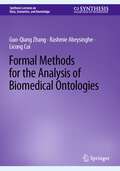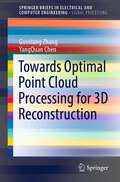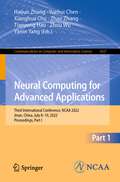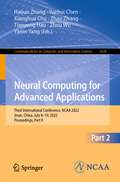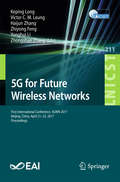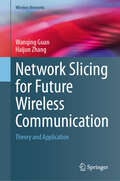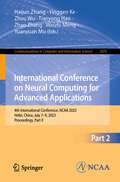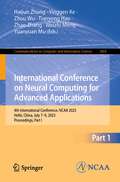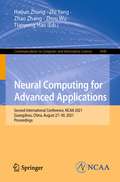- Table View
- List View
R for Programmers: Mastering the Tools
by Dan ZhangUnlike other books about R, written from the perspective of statistics, this book is written from the perspective of programmers, providing a channel for programmers with expertise in other programming languages to quickly understand R. The contents are divided into four parts: the basics of R, the server of R, databases and big data, and the appendices, which introduce the installation of Java, various databases, and Hadoop. Because this is a reference book, there is no special sequence for reading all the chapters. Anyone new to the subject who wishes to master R comprehensively can simply follow the chapters in sequence.
Graph Learning in Medical Imaging: First International Workshop, GLMI 2019, Held in Conjunction with MICCAI 2019, Shenzhen, China, October 17, 2019, Proceedings (Lecture Notes in Computer Science #11849)
by Daoqiang Zhang Luping Zhou Biao Jie Mingxia LiuThis book constitutes the refereed proceedings of the First International Workshop on Graph Learning in Medical Imaging, GLMI 2019, held in conjunction with MICCAI 2019 in Shenzhen, China, in October 2019. The 21 full papers presented were carefully reviewed and selected from 42 submissions. The papers focus on major trends and challenges of graph learning in medical imaging and present original work aimed to identify new cutting-edge techniques and their applications in medical imaging.
3D Biometrics: Systems and Applications
by David Zhang Guangming LuAutomatic personal authentication using biometric information is becoming more essential in applications of public security, access control, forensics, banking, etc. Many kinds of biometric authentication techniques have been developed based on different biometric characteristics. However, most of the physical biometric recognition techniques are based on two dimensional (2D) images, despite the fact that human characteristics are three dimensional (3D) surfaces. Recently, 3D techniques have been applied to biometric applications such as 3D face, 3D palmprint, 3D fingerprint, and 3D ear recognition. This book introduces four typical 3D imaging methods, and presents some case studies in the field of 3D biometrics. This book also includes many efficient 3D feature extraction, matching, and fusion algorithms. These 3D imaging methods and their applications are given as follows: - Single view imaging with line structured-light: 3D ear identification - Single view imaging with multi-line structured-light: 3D palmprint authentication - Single view imaging using only 3D camera: 3D hand verification - Multi-view imaging: 3D fingerprint recognition 3D Biometrics: Systems and Applications is a comprehensive introduction to both theoretical issues and practical implementation in 3D biometric authentication. It will serve as a textbook or as a useful reference for graduate students and researchers in the fields of computer science, electrical engineering, systems science, and information technology. Researchers and practitioners in industry and R&D laboratories working on security system design, biometrics, immigration, law enforcement, control, and pattern recognition will also find much of interest in this book.
Electronic Nose: Algorithmic Challenges
by David Zhang Fengchun Tian Lei ZhangThis book presents the key technology of electronic noses, and systematically describes how e-noses can be used to automatically analyse odours. Appealing to readers from the fields of artificial intelligence, computer science, electrical engineering, electronics, and instrumentation science, it addresses three main areas: First, readers will learn how to apply machine learning, pattern recognition and signal processing algorithms to real perception tasks. Second, they will be shown how to make their algorithms match their systems once the algorithms don’t work because of the limitation of hardware resources. Third, readers will learn how to make schemes and solutions when the acquired data from their systems is not stable due to the fundamental issues affecting perceptron devices (e.g. sensors). In brief, the book presents and discusses the key technologies and new algorithmic challenges in electronic noses and artificial olfaction. The goal is to promote the industrial application of electronic nose technology in environmental detection, medical diagnosis, food quality control, explosive detection, etc. and to highlight the scientific advances in artificial olfaction and artificial intelligence. The book offers a good reference guide for newcomers to the topic of electronic noses, because it refers to the basic principles and algorithms. At the same time, it clearly presents the key challenges – such as long-term drift, signal uniqueness, and disturbance – and effective and efficient solutions, making it equally valuable for researchers engaged in the science and engineering of sensors, instruments, chemometrics, etc.
Pathological Voice Analysis
by David Zhang Kebin WuWhile voice is widely used in speech recognition and speaker identification, its application in biomedical fields is much less common. This book systematically introduces the authors’ research on voice analysis for biomedical applications, particularly pathological voice analysis. Firstly, it reviews the field to highlight the biomedical value of voice. It then offers a comprehensive overview of the workflow and aspects of pathological voice analysis, including voice acquisition systems, voice pitch estimation methods, glottal closure instant detection, feature extraction and learning, and the multi-audio fusion approaches. Lastly, it discusses the experimental results that have shown the superiority of these techniques. This book is useful to researchers, professionals and postgraduate students working in fields such as speech signal processing, pattern recognition, and biomedical engineering. It is also a valuable resource for those involved in interdisciplinary research.
Fundamentals of Image Data Mining: Analysis, Features, Classification and Retrieval (Texts in Computer Science)
by Dengsheng ZhangThis reader-friendly textbook presents a comprehensive review of the essentials of image data mining, and the latest cutting-edge techniques used in the field. The coverage spans all aspects of image analysis and understanding, offering deep insights into areas of feature extraction, machine learning, and image retrieval. The theoretical coverage is supported by practical mathematical models and algorithms, utilizing data from real-world examples and experiments.Topics and features: describes the essential tools for image mining, covering Fourier transforms, Gabor filters, and contemporary wavelet transforms; reviews a varied range of state-of-the-art models, algorithms, and procedures for image mining; emphasizes how to deal with real image data for practical image mining; highlights how such features as color, texture, and shape can be mined or extracted from images for image representation; presents four powerful approaches for classifying image data, namely, Bayesian classification, Support Vector Machines, Neural Networks, and Decision Trees; discusses techniques for indexing, image ranking, and image presentation, along with image database visualization methods; provides self-test exercises with instructions or Matlab code, as well as review summaries at the end of each chapter.This easy-to-follow work illuminates how concepts from fundamental and advanced mathematics can be applied to solve a broad range of image data mining problems encountered by students and researchers of computer science. Students of mathematics and other scientific disciplines will also benefit from the applications and solutions described in the text, together with the hands-on exercises that enable the reader to gain first-hand experience of computing.
Fundamentals of Image Data Mining: Analysis, Features, Classification and Retrieval (Texts in Computer Science)
by Dengsheng ZhangThis unique and useful textbook presents a comprehensive review of the essentials of image data mining, and the latest cutting-edge techniques used in the field. The coverage spans all aspects of image analysis and understanding, offering deep insights into areas of feature extraction, machine learning, and image retrieval. The theoretical coverage is supported by practical mathematical models and algorithms, utilizing data from real-world examples and experiments. Topics and features: Describes essential tools for image mining, covering Fourier transforms, Gabor filters, and contemporary wavelet transformsDevelops many new exercises (most with MATLAB code and instructions)Includes review summaries at the end of each chapterAnalyses state-of-the-art models, algorithms, and procedures for image miningIntegrates new sections on pre-processing, discrete cosine transform, and statistical inference and testingDemonstrates how features like color, texture, and shape can be mined or extracted for image representationApplies powerful classification approaches: Bayesian classification, support vector machines, neural networks, and decision treesImplements imaging techniques for indexing, ranking, and presentation, as well as database visualization This easy-to-follow, award-winning book illuminates how concepts from fundamental and advanced mathematics can be applied to solve a broad range of image data mining problems encountered by students and researchers of computer science. Students of mathematics and other scientific disciplines will also benefit from the applications and solutions described in the text, together with the hands-on exercises that enable the reader to gain first-hand experience of computing.
Resource Management for Energy and Spectrum Harvesting Sensor Networks
by Deyu Zhang Zhigang Chen Haibo Zhou Xuemin Sherman ShenThis SpringerBrief offers a comprehensive review and in-depth discussion of the current research on resource management. The authors explain how to best utilize harvested energy and temporally available licensed spectrum. Throughout the brief, the primary focus is energy and spectrum harvesting sensor networks (ESHNs) including energy harvesting (EH)-powered spectrum sensing and dynamic spectrum access. To efficiently collect data through the available licensed spectrum, this brief examines the joint management of energy and spectrum. An EH-powered spectrum sensing and management scheme for Heterogeneous Spectrum Harvesting Sensor Networks (HSHSNs) is presented in this brief. The scheme dynamically schedules the data sensing and spectrum access of sensors in ESHSNs to optimize the network utility, while considering the stochastic nature of EH process, PU activities and channel conditions. This brief also provides useful insights for the practical resource management scheme design for ESHSNs and motivates a new line of thinking for future sensor networking. Professionals, researchers, and advanced-level students in electrical or computer engineering will find the content valuable.
Assessing L2 Digital Multimodal Composing Competence (Routledge Focus on Applied Linguistics)
by Emily Di Zhang Shulin YuThis book focuses on assessing L2 student digital multimodal composing (DMC) competence. It explores key themes, including the conceptualization of L2 student DMC competence, and the development, validation, and utilization of L2 student DMC competence in the tertiary context.Through a thorough review of the DMC literature, the book furnishes readers with a theoretical framework to comprehensively grasp the underlying constructs of L2 student DMC competence. It also provides a delineation of the process of scale development, i.e., defining constructs, constructing items, and analyzing items, scale validation, i.e., the structural, external, and consequential construct validity of the scale, and scale utilization in students’ DMC self- and peer-assessment practices.This practical guidance equips educators and practitioners with the necessary tools and strategies to effectively assess and enhance L2 students’ DMC competence. Scholars and professionals in the fields of L2 writing, language assessment, digital literacy, and technology-enhanced language learning will gain valuable insights from the content.
Genetic Programming for Production Scheduling: An Evolutionary Learning Approach (Machine Learning: Foundations, Methodologies, and Applications)
by Fangfang Zhang Su Nguyen Yi Mei Mengjie ZhangThis book introduces readers to an evolutionary learning approach, specifically genetic programming (GP), for production scheduling. The book is divided into six parts. In Part I, it provides an introduction to production scheduling, existing solution methods, and the GP approach to production scheduling. Characteristics of production environments, problem formulations, an abstract GP framework for production scheduling, and evaluation criteria are also presented. Part II shows various ways that GP can be employed to solve static production scheduling problems and their connections with conventional operation research methods. In turn, Part III shows how to design GP algorithms for dynamic production scheduling problems and describes advanced techniques for enhancing GP’s performance, including feature selection, surrogate modeling, and specialized genetic operators. In Part IV, the book addresses how to use heuristics to deal with multiple, potentially conflicting objectives in production scheduling problems, and presents an advanced multi-objective approach with cooperative coevolution techniques or multi-tree representations. Part V demonstrates how to use multitask learning techniques in the hyper-heuristics space for production scheduling. It also shows how surrogate techniques and assisted task selection strategies can benefit multitask learning with GP for learning heuristics in the context of production scheduling. Part VI rounds out the text with an outlook on the future.Given its scope, the book benefits scientists, engineers, researchers, practitioners, postgraduates, and undergraduates in the areas of machine learning, artificial intelligence, evolutionary computation, operations research, and industrial engineering.
Computational Visual Media: 12th International Conference, CVM 2024, Wellington, New Zealand, April 10–12, 2024, Proceedings, Part II (Lecture Notes in Computer Science #14593)
by Fang-Lue Zhang Andrei SharfThis book constitutes the refereed proceedings of CVM 2024, the 12th International Conference on Computational Visual Media, held in Wellington, New Zealand, in April 2024.The 34 full papers were carefully reviewed and selected from 212 submissions. The papers are organized in topical sections as follows:Part I: Reconstruction and Modelling, Point Cloud, Rendering and Animation, User Interations.Part II: Facial Images, Image Generation and Enhancement, Image Understanding, Stylization, Vision Meets Graphics.
Computational Visual Media: 12th International Conference, CVM 2024, Wellington, New Zealand, April 10–12, 2024, Proceedings, Part I (Lecture Notes in Computer Science #14592)
by Fang-Lue Zhang Andrei SharfThis book constitutes the refereed proceedings of CVM 2024, the 12th International Conference on Computational Visual Media, held in Wellington, New Zealand, in April 2024.The 34 full papers were carefully reviewed and selected from 212 submissions. The papers are organized in topical sections as follows:Part I: Reconstruction and Modelling, Point Cloud, Rendering and Animation, User Interations.Part II: Facial Images, Image Generation and Enhancement, Image Understanding, Stylization, Vision Meets Graphics.
Computer-Enhanced and Mobile-Assisted Language Learning: Emerging Issues and Trends
by Felicia ZhangAs the field of Information and Communication Technologies rapidly expands, the applications to language learning continue to grow. Computer-Enhanced and Mobile-Assisted Language Learning: Emerging Issues and Trends compiles the latest research into computer-enhanced language learning, as well as the integration of mobile devices into new language acquisition. Though new information is constantly coming out as technologies continue to evolve, this important new follow-up publication will be distributed worldwide among academic and professional institutions and will be instrumental in providing researchers, scholars, students, and professionals access to the latest knowledge related to research on computer-enhanced and mobile assisted language learning.
High-speed Serial Buses in Embedded Systems
by Feng ZhangThis book describes the most frequently used high-speed serial buses in embedded systems, especially those used by FPGAs. These buses employ SerDes, JESD204, SRIO, PCIE, Aurora and SATA protocols for chip-to-chip and board-to-board communication, and CPCIE, VPX, FC and Infiniband protocols for inter-chassis communication. For each type, the book provides the bus history and version info, while also assessing its advantages and limitations. Furthermore, it offers a detailed guide to implementing these buses in FPGA design, from the physical layer and link synchronization to the frame format and application command. Given its scope, the book offers a valuable resource for researchers, R&D engineers and graduate students in computer science or electronics who wish to learn the protocol principles, structures and applications of high-speed serial buses.
Web Information Systems Engineering – WISE 2023: 24th International Conference, Melbourne, VIC, Australia, October 25–27, 2023, Proceedings (Lecture Notes in Computer Science #14306)
by Feng Zhang Hua Wang Mahmoud Barhamgi Lu Chen Rui ZhouThis book constitutes the proceedings of the 24th International Conference on Web Information Systems Engineering, WISE 2023, held in Melbourne, Victoria, Australia, in October 2023.The 33 full and 40 short papers were carefully reviewed and selected from 137 submissions. They were organized in topical sections as follows: text and sentiment analysis; question answering and information retrieval; social media and news analysis; security and privacy; web technologies; graph embeddings and link predictions; predictive analysis and machine learning; recommendation systems; natural language processing (NLP) and databases; data analysis and optimization; anomaly and threat detection; streaming data; miscellaneous; explainability and scalability in AI.
Network and Parallel Computing: IFIP International Conference, NPC 2007, Dalian, China, September 18-21, 2007, Proceedings (Lecture Notes in Computer Science #4672)
by Feng Zhang Jidong Zhai Marc Snir Hai Jin Hironori Kasahara Mateo ValeroThis book constitutes the proceedings of the 15th IFIP International Conference on Network and Parallel Computing, NPC 2018, held in Muroran, Japan, in November/December 2018. <P><P>The 22 full and 12 short papers presented in this volume were carefully reviewed and selected from 72 submissions. The papers cover traditional areas of network and parallel computing, including parallel applications, distributed algorithms, parallel architectures, software environments, and distributed tools.
Formal Methods for the Analysis of Biomedical Ontologies (Synthesis Lectures on Data, Semantics, and Knowledge)
by Guo-Qiang Zhang Rashmie Abeysinghe Licong CuiThe book synthesizes research on the analysis of biomedical ontologies using formal concept analysis, including through auditing, curation, and enhancement. As the evolution of biomedical ontologies almost inevitably involves manual work, formal methods are a particularly useful tool for ontological engineering and practice, particularly in uncovering unexpected "bugs" and content materials. The book first introduces simple but formalized strategies for discovering undesired and incoherent patterns in ontologies before exploring the application of formal concept analysis for semantic completeness. The book then turns to formal concept analysis, a classical approach used in the mathematical treatment of orders and lattices, as an ontological engineering principle, focusing on the structural property of ontologies with respect to its conformation to lattice or not (non-lattice). The book helpfully covers the development of more efficient algorithms for non-lattice detection and extraction required by exhaustive lattice/non-lattice analysis. The book goes on to highlight the power and utility of uncovering non-lattice structure for debugging ontologies and describes methods that leverage the linguistic information in concept names (labels) for ontological analysis. It also addresses visualization and performance evaluation issues before closing with an overview and forward-looking perspectives on the field. This book is intended for graduate students and researchers interested in biomedical ontologies and their applications. It can be a useful supplement for courses on knowledge representation and engineering and also provide readers with a reference for related scientific publications and literature to assist in identifying potential research topics. All mathematical concepts and notations used in this book can be found in standard discrete mathematics textbooks, and the appendix at the end of the book provides a list of key ontological resources, as well as annotated non-lattice and lattice examples that were discovered using the authors' methods, demonstrating how "bugs are fixed" by converting non-lattices to lattices with minimal edit changes.
Towards Optimal Point Cloud Processing for 3D Reconstruction (SpringerBriefs in Electrical and Computer Engineering)
by Guoxiang Zhang YangQuan ChenThis SpringerBrief presents novel methods of approaching challenging problems in the reconstruction of accurate 3D models and serves as an introduction for further 3D reconstruction methods. It develops a 3D reconstruction system that produces accurate results by cascading multiple novel loop detection, sifting, and optimization methods.The authors offer a fast point cloud registration method that utilizes optimized randomness in random sample consensus for surface loop detection. The text also proposes two methods for surface-loop sifting. One is supported by a sparse-feature-based optimization graph. This graph is more robust to different scan patterns than earlier methods and can cope with tracking failure and recovery. The other is an offline algorithm that can sift loop detections based on their impact on loop optimization results and which is enabled by a dense map posterior metric for 3D reconstruction and mapping performance evaluation works without any costly ground-truth data. The methods presented in Towards Optimal Point Cloud Processing for 3D Reconstruction will be of assistance to researchers developing 3D modelling methods and to workers in the wide variety of fields that exploit such technology including metrology, geological animation and mass customization in smart manufacturing.
Neural Computing for Advanced Applications: Third International Conference, NCAA 2022, Jinan, China, July 8–10, 2022, Proceedings, Part I (Communications in Computer and Information Science #1637)
by Haijun Zhang Yuehui Chen Xianghua Chu Zhao Zhang Tianyong Hao Zhou Wu Yimin YangThe two-volume Proceedings set CCIS 1637 and 1638 constitutes the refereed proceedings of the Third International Conference on Neural Computing for Advanced Applications, NCAA 2022, held in Jinan, China, during July 8–10, 2022. The 77 papers included in these proceedings were carefully reviewed and selected from 205 submissions. These papers were categorized into 10 technical tracks, i.e., neural network theory, and cognitive sciences, machine learning, data mining, data security & privacy protection, and data-driven applications, computational intelligence, nature-inspired optimizers, and their engineering applications, cloud/edge/fog computing, the Internet of Things/Vehicles (IoT/IoV), and their system optimization, control systems, network synchronization, system integration, and industrial artificial intelligence, fuzzy logic, neuro-fuzzy systems, decision making, and their applications in management sciences, computer vision, image processing, and their industrial applications, natural language processing, machine translation, knowledge graphs, and their applications, Neural computing-based fault diagnosis, fault forecasting, prognostic management, and system modeling, and Spreading dynamics, forecasting, and other intelligent techniques against coronavirus disease (COVID-19).
Neural Computing for Advanced Applications: Third International Conference, NCAA 2022, Jinan, China, July 8–10, 2022, Proceedings, Part II (Communications in Computer and Information Science #1638)
by Haijun Zhang Yuehui Chen Xianghua Chu Zhao Zhang Tianyong Hao Zhou Wu Yimin YangThe two-volume Proceedings set CCIS 1637 and 1638 constitutes the refereed proceedings of the Third International Conference on Neural Computing for Advanced Applications, NCAA 2022, held in Jinan, China, during July 8–10, 2022. The 77 papers included in these proceedings were carefully reviewed and selected from 205 submissions. These papers were categorized into 10 technical tracks, i.e., neural network theory, and cognitive sciences, machine learning, data mining, data security & privacy protection, and data-driven applications, computational intelligence, nature-inspired optimizers, and their engineering applications, cloud/edge/fog computing, the Internet of Things/Vehicles (IoT/IoV), and their system optimization, control systems, network synchronization, system integration, and industrial artificial intelligence, fuzzy logic, neuro-fuzzy systems, decision making, and their applications in management sciences, computer vision, image processing, and their industrial applications, natural language processing, machine translation, knowledge graphs, and their applications, Neural computing-based fault diagnosis, fault forecasting, prognostic management, and system modeling, and Spreading dynamics, forecasting, and other intelligent techniques against coronavirus disease (COVID-19).
5G for Future Wireless Networks: First International Conference, 5GWN 2017, Beijing, China, April 21-23, 2017, Proceedings (Lecture Notes of the Institute for Computer Sciences, Social Informatics and Telecommunications Engineering #211)
by Haijun Zhang Zhiyong Feng Victor C.M. Leung Yonghui Li Keping Long Zhongshan ZhangThis book constitutes the proceedings of the First International Conference on 5G for Future Wireless Networks, 5GWN 2017, held in Beijing, China, in April 2017. The 64 full papers were selected from 135 submissions and present the state of the art and practical applications of 5G technologies. The exponentially growing data traffic caused by the development of mobile Internet and smart phones requires powerful networks. The fifth generation (5G) techniques are promising to meet the requirements of this explosive data traffic in future mobile communications.
Network Slicing for Future Wireless Communication: Theory and Application (Wireless Networks)
by Haijun Zhang Wanqing GuanThis book comprehensively discusses the development, application and challenges of network slicing technology in wireless communications. Starting with the basic concept and enabling technologies of network slicing, this book introduces how to integrate AI (Artificial Intelligence) technology into the end-to-end deployment, resource allocation and performance enhancement for multi-tenant slicing. An in-depth exploration of managing multi-domain slices deployed in the federated infrastructure networks is presented, including on-demand cooperation among multiple infrastructure networks, distinct slice deployment, hierarchical slice orchestration and fast slice adaption. As a guide to leveraging AI to enhance traffic performance of multi-tenant slicing and customize resource slicing for industrial scenarios, this book provides insights, modeling, applications and research issues. A holistic perspective on prominent role of network slicing in managing wireless network resources is provided as well. Overall, network slicing as a key technology of wireless networks, enables to satisfy differentiated service demands of multiple tenants from vertical industries with the same shared physical infrastructure network. As future wireless networks are expected to facilitate the evolution of vertical industries, various vertical enterprises as tenants require an intelligent network slicing paradigm to provide highly customizable services. AI-based management system for network slicing excel at deploying slices rapidly, allocating resources efficiently and avoiding service quality degradation. With the increasing diversity of service demands and complexity of communication environment, incorporating AI into network slicing is a necessity for improving flexibility and automation of resource management. This book targets advanced-level students in information and communication sciences as a secondary textbook. Researchers and industry professionals working in various areas, such as wireless communication systems, network management and orchestration, resource allocation and AI-enabled wireless networks will also find this book useful as reference book.
International Conference on Neural Computing for Advanced Applications: 4th International Conference, NCAA 2023, Hefei, China, July 7–9, 2023, Proceedings, Part II (Communications in Computer and Information Science #1870)
by Haijun Zhang Yinggen Ke Zhou Wu Tianyong Hao Zhao Zhang Weizhi Meng Yuanyuan MuThe two-volume set CCIS 1869 and 1870 constitutes the refereed proceedings of the 4th International Conference on Neural Computing for Advanced Applications, NCAA 2023, held in Hefei, China, in July 2023.The 83 full papers and 1 short paper presented in these proceedings were carefully reviewed and selected from 211 submissions. The papers have been organized in the following topical sections: Neural network (NN) theory, NN-based control systems, neuro-system integration and engineering applications; Machine learning and deep learning for data mining and data-driven applications; Computational intelligence, nature-inspired optimizers, and their engineering applications; Deep learning-driven pattern recognition, computer vision and its industrial applications; Natural language processing, knowledge graphs, recommender systems, and their applications; Neural computing-based fault diagnosis and forecasting, prognostic management, and cyber-physical system security; Sequence learning for spreading dynamics, forecasting, and intelligent techniques against epidemic spreading (2); Applications of Data Mining, Machine Learning and Neural Computing in Language Studies; Computational intelligent Fault Diagnosis and Fault-Tolerant Control, and Their Engineering Applications; and Other Neural computing-related topics.
International Conference on Neural Computing for Advanced Applications: 4th International Conference, NCAA 2023, Hefei, China, July 7–9, 2023, Proceedings, Part I (Communications in Computer and Information Science #1869)
by Haijun Zhang Yinggen Ke Zhou Wu Tianyong Hao Zhao Zhang Weizhi Meng Yuanyuan MuThe two-volume set CCIS 1869 and 1870 constitutes the refereed proceedings of the 4th International Conference on Neural Computing for Advanced Applications, NCAA 2023, held in Hefei, China, in July 2023.The 83 full papers and 1 short paper presented in these proceedings were carefully reviewed and selected from 211 submissions. The papers have been organized in the following topical sections: Neural network (NN) theory, NN-based control systems, neuro-system integration and engineering applications; Machine learning and deep learning for data mining and data-driven applications; Computational intelligence, nature-inspired optimizers, and their engineering applications; Deep learning-driven pattern recognition, computer vision and its industrial applications; Natural language processing, knowledge graphs, recommender systems, and their applications; Neural computing-based fault diagnosis and forecasting, prognostic management, and cyber-physical system security; Sequence learning for spreading dynamics, forecasting, and intelligent techniques against epidemic spreading (2); Applications of Data Mining, Machine Learning and Neural Computing in Language Studies; Computational intelligent Fault Diagnosis and Fault-Tolerant Control, and Their Engineering Applications; and Other Neural computing-related topics.
Neural Computing for Advanced Applications: Second International Conference, NCAA 2021, Guangzhou, China, August 27-30, 2021, Proceedings (Communications in Computer and Information Science #1449)
by Haijun Zhang Zhi Yang Zhao Zhang Zhou Wu Tianyong HaoThis book presents refereed proceedings of the Second International Conference Neural Computing for Advanced Applications, NCAA 2021, held in Guangzhou, China, in August, 2021. The 54 full papers papers were thorougly reviewed and selected from a total of 144 qualified submissions. The papers are organized in topical sections on neural network theory, cognitive sciences, neuro-system hardware implementations, and NN-based engineering applications; machine learning, data mining, data security and privacy protection, and data-driven applications; neural computing-based fault diagnosis, fault forecasting, prognostic management, and system modeling; computational intelligence, nature-inspired optimizers, and their engineering applications; fuzzy logic, neuro-fuzzy systems, decision making, and their applications in management sciences; control systems, network synchronization, system integration, and industrial artificial intelligence; computer vision, image processing, and their industrial applications; cloud/edge/fog computing, the Internet of Things/Vehicles(IoT/IoV), and their system optimization; spreading dynamics, forecasting, and other intelligent techniques against coronavirus disease (COVID-19).
